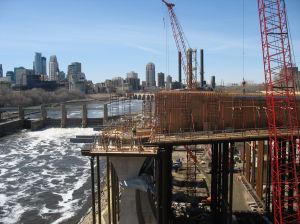Report: 6 ideas to fix the U.S. infrastructure mess


Earlier this week, I listened in on a seminar about trends in U.S. infrastructure investments, in particular investments in transportation project. The discussion centered on some research from the Urban Land Institute and Ernst & Young that shows (as you might expect) that the United States is trailing several emerging economies -- China, India and Brazil. That probably doesn't surprise you at all, given all the fighting going on about budget deficits and depressed real estate values and such. It didn't surprise me. But here is what we are up against:
- China plans to spend $1 trillion (yes, with a "t") on things including the 10,000-mile high-speed rail network planned by 2020. New airports, ports and subways are also on the planning boards. This is to be expected from the world's fastest emerging economy.
- India also has roughly the same number allocated: what makes its plans particularly interesting, according to the report, is the fact that the country is relying heavily on private money to help with this build out. Part of me is really excited by that idea but then I started thinking about all the sports stadium projects that "private" money has inspired, which winds up being shouldered by taxpayers.There's one really great example of that here in my own backyard in the form of the new Meadowlands sports stadium. But I digress.
- Brazil has an estimated $900 billion allocated for road, transit and water projects; it is being inspired by its preparation for both the World Cup and the Summer Olympics
- Even in the United Kingdom, which you could argue has been hurting just as much economically as the United States, has committed $326 billion to national infrastructure projects.
Meanwhile, infrastructure spending in the United States peaked as a share of the gross domestic product at 3.1 percent early in the 1960s. By 2007, it was 2.4 percent of GDP.
Let me say for the record that I know there is a big difference between the sort of spending that an established economy like the United States should be doing and what an emerging economy ala China, India or Brazil might be expected to invest. But the fact is, there is a lot of aging infrastructure in the United States and the nation doesn't seem inclined to do much about it. The mentality here is to cut as much spending as possible. Here's an observation from Howard Roth, the Global Real Estate Leader for Ernst & Young:
"For those who have read our infrastructure reports over recent years, one consistent finding is that the U.S. seriously lags behind the rest of the world in addressing its infrastructure issues. The U.S. is facing federal, state and municipal budget deficits, lacks any type of comprehensive national policy or the political will to develop a long-term approach to funding the significant maintenance needs of aging U.S. infrastructure, much less the modernization and greenfield development of critically needed new projects. We need to refocus our priorities; streamline the procurement process, attract private capital more efficiently, strategically invest in projects with national merit, and regain our stature as a global competitor. We need to take a page out of the playbooks of several nations around the world highlighted in our report, or we face the risk of serious deterioration of our country's economic and social well-being.
Constructively speaking, the hefty Urban Land Institute report, "Infrastructure 2011: A Strategic Priority," offers a number of recommendations for the United States to get out of its infrastructure mess. Here are 6 things that the report suggests would help address the problem.
- Prioritize repairs and maintenance over big-ticket capital projects (even though they don't make for sexy headlines). Pooling regional resources and encouraging help from the private sector could be effective. One example cited on the seminar this week was Envision Utah, which is pooling resources of more than 100 communities across the state.
- Develop a national strategy, prioritizing the things that make sense from a national standpoint. (Can you imagine the lobbying?)
- Remember to think urban. The reality is that the United States is increasingly metropolitan country with something like 85 percent of our population -- and our GDP -- focused there. Accordingly, that's where the most investment should be focused.
- Ensure long-term funding, which will in turn perk up the idea of private investments. The way money is currently allocated -- on an annual basis -- doesn't provide much confidence for private investors.
- Develop new funding models including (gasp) user fees for the people actually use the system and (gasp) local taxes. Another approach would be to establish infrastructure financing models.
- Plan ahead for maintenance. In other words, new projects shouldn't just account for the capital costs, they need to properly plan for the long-term maintenance.
It took the United States years to get to this point with respect to its infrastructure and it will take years to fix the problem. Let's just hope that it doesn't take another emergency the size of Hurricane Katrina to set the wheels in motion.
This post was originally published on Smartplanet.com